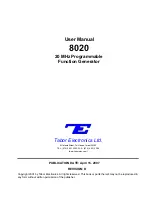
ENGLISH
81
6.6.5 GI: Integral gain coefficient
In the event of significant pressure drops on sudden increases in flow, or a slow system response, increase
the value of GI. Otherwise, in the event of pressure oscillations around the setpoint, reduce the value of GI.
A typical example in which the value of GI should be reduced is that in which the inverter is located far
from the electric pump. This distance causes hydraulic elasticity which influences control of PI and
therefore pressure regulation
.
IMPORTANT: To obtain satisfactory pressure settings, both values GP and GI should be adjusted.
6.6.6 FS: Maximum rotation frequency
This sets the maximum pump rotation frequency.
This sets a maximum rpm limit and can be set between FN and FN - 20%.
FS, in any conditions of regulation, ensures that the electric pump is never controlled at a frequency higher than the
set value.
FS can be automatically reconfigured following modifications to FN, when the above ratio is not verified (e.g. if the
value of FS is less than FN - 20%, FS will be reset to FN - 20%).
6.6.7 FL: Minimum rotation frequency
FL is used to set the minimum pump rotation frequency. The minimum admissible value is 0 [Hz], and the maximum is
80% of FN; for example, if FN = 50 [Hz], FL can be set between 0 and 40[Hz].
FL can be automatically reconfigured following modifications to FN, when the above ratio is not verified (e.g. if the
value of FL is greater than 80% of the set FN value, FL will be reset to 80% of FN).
Set a minimum frequency according to the pump manufacturer's specifications
.
The inverter will not control the pump at a frequency below FL; this means that if the pump, at the
frequency FL, generates a pressure above the set point, there will be a pressure overload in the system.
6.6.8 Setting the number of inverters and reserves
6.6.8.1 NA: Active inverters
This sets the maximum number of inverters involved in pumping.
It can be set with a value between 1 and the number of inverters present (max. 8). The default value for NA is N, i.e.
the number of inverters in the series; this means that if inverters are removed or inserted in the series, NA always has
the same number as that of the inverters, as read automatically. If a value other than N is entered, the system sets to
the maximum number of inverters that can be involved in pumping.
This parameter is used when there is a limited number of pumps to be kept in operation, and if one or more inverters
are to be kept as reserves (see IC: Configurazione della riserva section 6.6.8.3 and the following examples).
In the same menu page, the user can view (without the option of modification) a further two system parameters related
to this value, i.e. N, the number of inverters detected automatically by the system, and NC, the maximum number of
simultaneous inverters.
6.6.8.2 NC: Simultaneous inverters
This sets the maximum number of inverters that can operate simultaneously.
It can be set with a value from 1 to NA. By default NC is set with the value NA; this means that whatever increase
applied to NA, NC is always set with the value of NA. If a different value from NA is set, the system sets to the set
maximum number of simultaneous inverters. This parameter is used when there is a limited number of pumps to be
kept in operation (see IC: Configurazione della riserva section 6.6.8.3 and the following examples).
In the same menu page, the user can view (without the option of modification) a further two system parameters related
to this value, i.e. N, the number of inverters detected automatically by the system, and NA, the number of active
inverters.
6.6.8.3 IC: Reserve configuration
This configures the inverter as automatic or reserve. If set to auto (default) the inverter participates in the normal
pumping process; if configured as reserve, it is assigned with minimum start-up priority, i.e. this inverter will be the last
to start up. If the number of active inverters setting is lower of one unit than the number of inverters present and one
element is set as reserve, this means that in normal operating conditions the reserve inverter does not participate in
normal pumping operations; otherwise if there is a fault on one of the active inverters, (power supply failure, safety
device trip etc.) the reserve inverter is started up.
The reserve configuration status can be checked as follows: in the SM page, the upper section of the icon is coloured;
in the AD and main pages, the communication icon representing the inverter address is displayed with the number on
a coloured background. There may be more than one inverter configured as reserve in a pumping system.















































